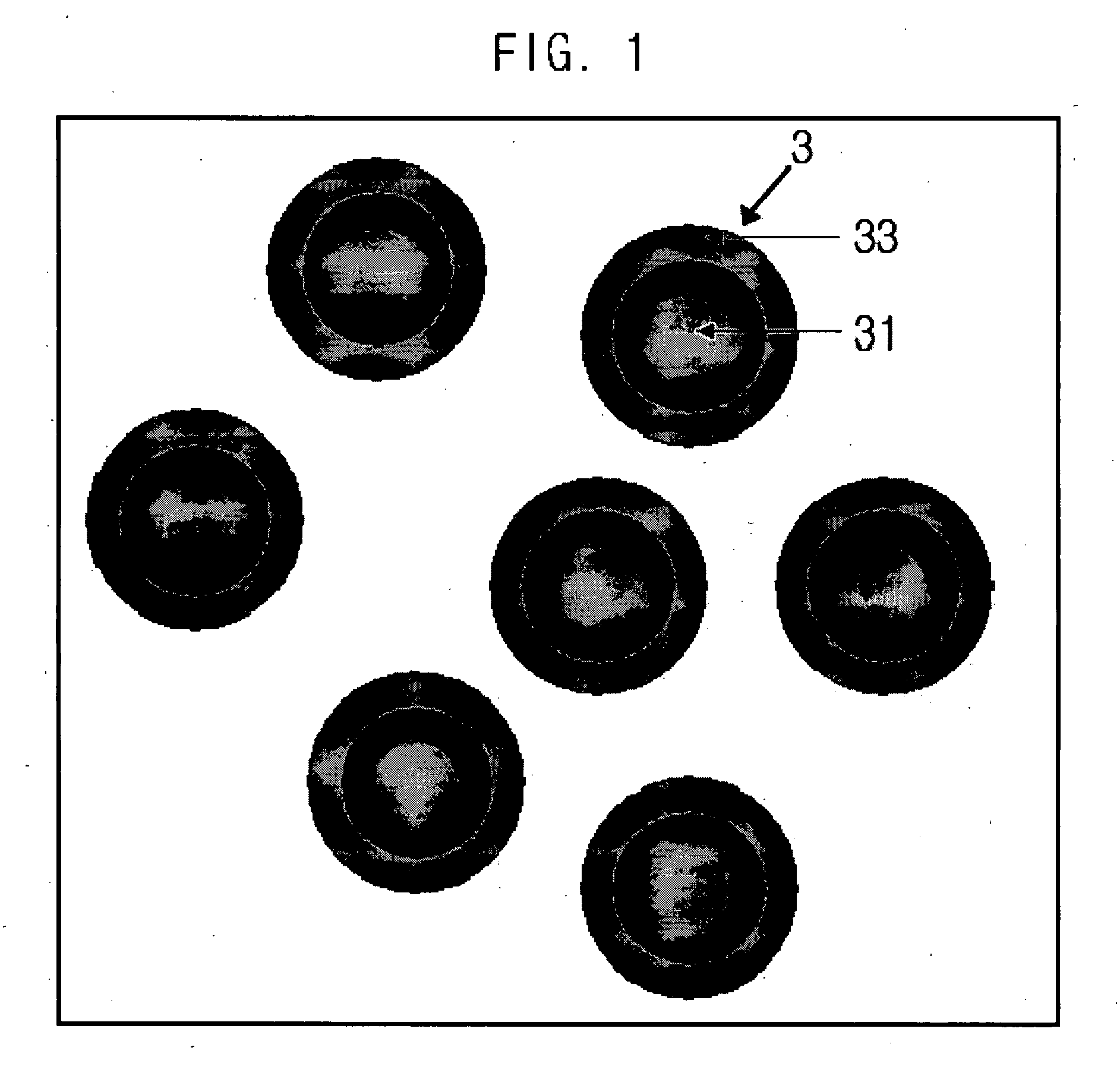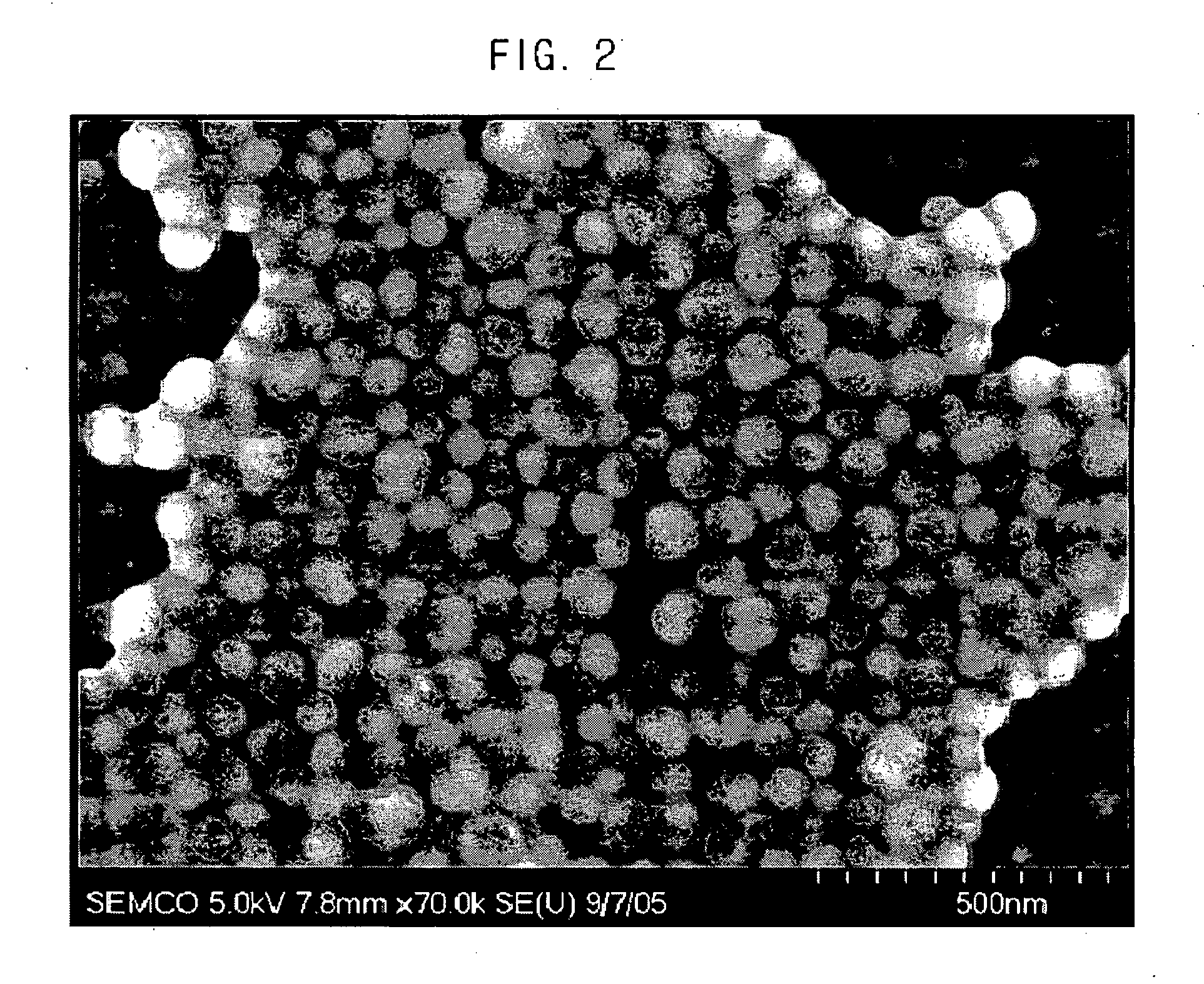Core-shell structure metal nanoparticles and its manufacturing method
- Summary
- Abstract
- Description
- Claims
- Application Information
AI Technical Summary
Benefits of technology
Problems solved by technology
Method used
Image
Examples
example 1
[0067] Oleylamine 100 g, copper acetylacetonate(C5H7CuO2) 7 g and ascorbic acid 5 g were put into a round flask equipped with a condenser and heated to 70° C. for 1 hour. After then, the temperature was raised to 250° C. by a rate of 5° C. / min, and the reaction solution was reacted for 30 min at 250° C. After the reaction solution was cooled to 150° C. by air-cooling, 2 g of Ag dodecanate was added and then the temperature was raised to 250° C. by a rate of 5° C. / min, and the reaction solution was reacted for 30 min at 23020 C. After the reaction completed, 300 ml of methanol was added and the nanoparticles were precipitated. These precipitates were washed with methanol more than 3 times and dried at 45° C. in a drying oven.
[0068]FIG. 2 is a SEM photo of the metal nanoparticles produced according to this procedure, FIG. 3 is particle distribution of the metal nanoparticles produced according to example 1, FIG. 4 is also a TEM photo of the metal nanoparticles produced according to e...
example 2
[0069] Oleylamine 50 g, 1-octadecene 50 g, copper acetylacetonate(C5H7CuO2) 20 g and ascorbic acid 15 g were put into a round flask equipped with a condenser and heated to 70° C. for 1 hour. After then, the temperature was raised to 110° C. by a rate of 5° C. / min, and the reaction solution was reacted for 1 hour. After the solution was cooled to 50° C. by air-cooling, 7 g of Ag dodecanate was added and then the temperature was raised to 110° C. by a rate of 5° C. / min, and the reaction solution was reated for 1 hour at 110° C. After the reaction completed, 300 ml of methanol was added and the nanoparticles were precipitated. These precipitates were washed with methanol more than 3 times and dried at 45° C. in a drying oven.
example 3
[0070] Oleylamine 50 g, xylene 50 g, copper acetylacetonate(C5H7CuO2) 20 g and ascorbic acid 15 g were put into a round flask equipped with a condenser and heated to 70° C. for 1 hour. After then, the temperature was raised to 250° C. by a rate of 5° C. / min, and the reaction solution was reacted for 30 min at 250° C. After the reaction solution was cooled to 50° C. by air-cooling, 7 g of Ag dodecanate was added and then the temperature was raised to 250° C. by a rate of 5 C / min, and the reaction solution was reacted for 30 min at 250° C. After the reaction completed, 300 ml of methanol was added and the nanoparticles were precipitated. These nanopricipitates were washed with methanol more than 3 times and dried at 45° C. in a drying oven.
PUM
| Property | Measurement | Unit |
|---|---|---|
| Time | aaaaa | aaaaa |
| Percent by mass | aaaaa | aaaaa |
| Percent by mass | aaaaa | aaaaa |
Abstract
Description
Claims
Application Information
 Login to View More
Login to View More - R&D
- Intellectual Property
- Life Sciences
- Materials
- Tech Scout
- Unparalleled Data Quality
- Higher Quality Content
- 60% Fewer Hallucinations
Browse by: Latest US Patents, China's latest patents, Technical Efficacy Thesaurus, Application Domain, Technology Topic, Popular Technical Reports.
© 2025 PatSnap. All rights reserved.Legal|Privacy policy|Modern Slavery Act Transparency Statement|Sitemap|About US| Contact US: help@patsnap.com



